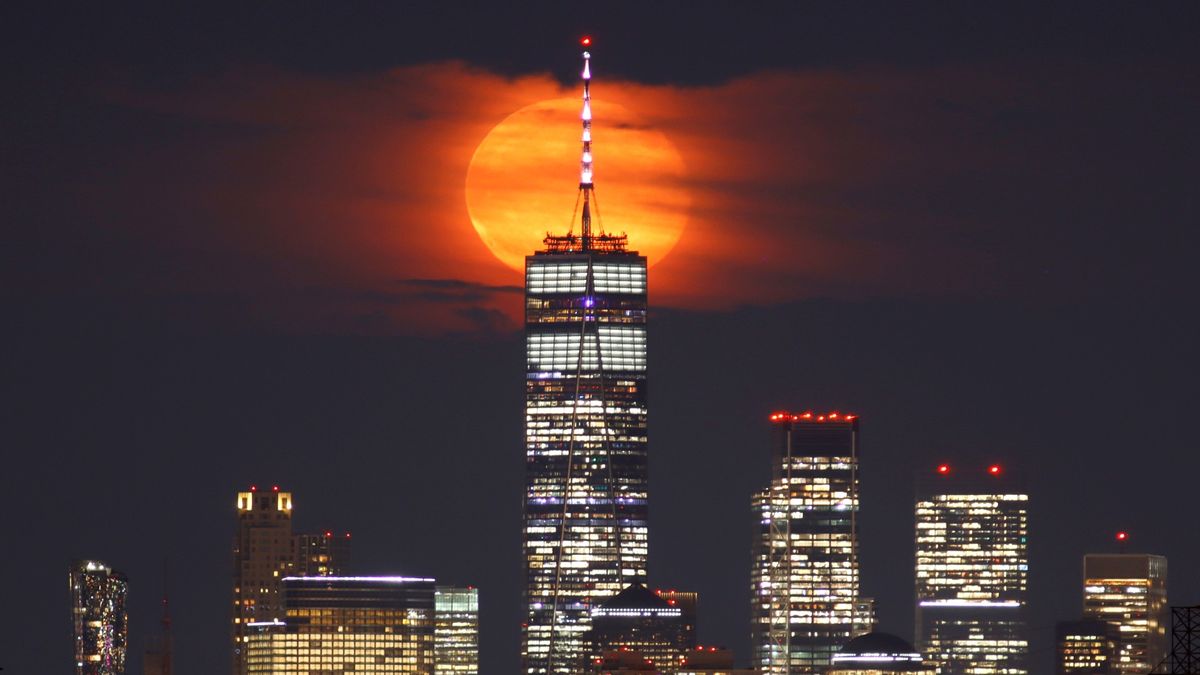Science
Related: About this forumJuly's Full Buck Moon, the 1st of 4 supermoons this summer, rises tonight
By Robert Lea last updated about 4 hours ago
The full moon on Monday, July 3, will mark a series of four supermoons in a row.

The Buck Moon or Thunder Moon rises behind lower Manhattan and One World Trade Center in New York City on July 14, 2022 (Image credit: Gary Hershorn/Getty Images)
July's full moon, also known as the Buck Moon, rises tonight (July 3) as a supermoon.
An exciting event for skywatchers, supermoons see the lunar disk appearing larger and brighter in the night sky, but the Buck Moon of 2023 will be even more thrilling as it kicks off a season of four supermoons in a row. Supermoons can lead to a 30% brightening of the moon and a 14% increase in the lunar disk as seen from Earth, but these differences usually aren't noticeable with the unaided eye unless one pays a lot of attention to the moon nightly.
Supermoons are the result of the moon being closer to Earth at the time of a full moon. Eclipse expert and retired NASA astrophysicist Fred Espanak told Space.com that during the July Buck Moon, the moon will be just 224,895 miles (361,934 kilometers) from Earth in comparison to its average distance of around 238,000 miles (382,900 km).
Supermoons occur because the orbit of the moon around Earth is not a perfect circle; as a result of Earth's gravitational influence, the moon's orbit is elliptical, appearing like an elongated circle or oval. This means there are times in the moon's 27-day orbit that it is closer to Earth and other times that it is further away.
A supermoon happens when the moon is both in the full moon phase of its 29.5 day lunar cycle and is at perigee, the closest point to Earth in its orbit.
More:
https://www.space.com/july-full-buck-moon-supermoons-summer
Judi Lynn
(162,495 posts)By Brett Tingley published about 6 hours ago
This full moon will mark the first of four supermoons that will rise this summer.
The Full Buck Moon will gallop through the sky tonight.
This full moon will mark the first of four straight supermoons that will rise over the next few months, beginning with July's Buck Moon tonight (July 3) and culminating with September's Full Corn Moon on Sept. 28. While the full moon never disappoints as a skywatching favorite, it can be tricky to see each full moon due to weather conditions or the timing of the moonrise.
Thankfully, astronomer Gianluca Masi and the Virtual Telescope Project in Rome, Italy will be livestreaming the Full Buck Moon in the night sky tonight for skywatchers unable to witness the first supermoon of 2023 in person. The livestream begins at 5 p.m. ET (2100 GMT) on Monday (July 3). Watch it here courtesy of the Virtual Telescope Project or on the project's YouTube channel.

The full moon is pictured with an airplane on July 3, 2023 in Istanbul, Türkiye. (Image credit: Hakan Akgun/dia images via Getty Images)
Supermoons occur when the moon is closer to Earth than average; because the moon's orbit around our planet is elliptical, or oval-shaped, there are times when our natural satellite appears slightly larger or smaller as its distance from us changes.
More:
https://www.space.com/full-moon-buck-supermoon-july-2023-livestream